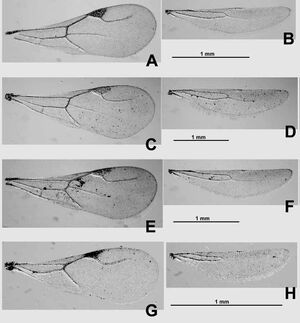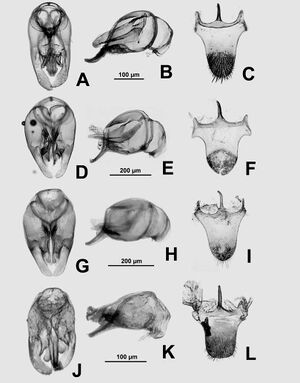Probolomyrmex vieti
| Probolomyrmex vieti | |
|---|---|

| |
| Scientific classification | |
| Kingdom: | Animalia |
| Phylum: | Arthropoda |
| Class: | Insecta |
| Order: | Hymenoptera |
| Family: | Formicidae |
| Subfamily: | Proceratiinae |
| Tribe: | Probolomyrmecini |
| Genus: | Probolomyrmex |
| Species: | P. vieti |
| Binomial name | |
| Probolomyrmex vieti Eguchi, Yoshimura & Yamane, 2006 | |
Nothing is known about the biology of Probolomyrmex vieti.
Identification
Eguchi et al. (2006) - In the worker, this species is barely separated from Probolomyrmex greavesi described from Capital Territory and S. Queensland, Australia (1 paratype worker and 1 paratype queen deposited in MCZC were examined), but the anteroventral portion of subpetiolar process projects anteroventrad in the worker of P. vieti. In the male, this species is rather clearly separated from P. greavesi by 1) masticatory margin of mandible with two teeth in addition to apical tooth, 2) dorsal margin of the node that is declining posteriorly and clearly divided from anterior and posterior faces, and 3) a broad and strong ventrolateral concavity on the apical segment of antenna.
Keys including this Species
Distribution
Known from the Indo-Chinese Peninsula and Java.
Latitudinal Distribution Pattern
Latitudinal Range: 11.983333° to -6.5975°.
| North Temperate |
North Subtropical |
Tropical | South Subtropical |
South Temperate |
- Source: AntMaps
Distribution based on Regional Taxon Lists
Indo-Australian Region: Indonesia, Singapore.
Oriental Region: Thailand, Vietnam (type locality).
Distribution based on AntMaps
Distribution based on AntWeb specimens
Check data from AntWeb
Countries Occupied
| Number of countries occupied by this species based on AntWiki Regional Taxon Lists. In general, fewer countries occupied indicates a narrower range, while more countries indicates a more widespread species. |

|
Estimated Abundance
| Relative abundance based on number of AntMaps records per species (this species within the purple bar). Fewer records (to the left) indicates a less abundant/encountered species while more records (to the right) indicates more abundant/encountered species. |

|
Biology
Castes
Male
 
| |
| . | |
Nomenclature
The following information is derived from Barry Bolton's Online Catalogue of the Ants of the World.
- vieti. Probolomyrmex vieti Eguchi, Yoshimura & Yamane, 2006: 29, figs. 7A-F, 9G, 14A-F, 15G, H, 16J-L (w.q.m.) VIETNAM, THAILAND, INDONESIA (Java).
- Type-material: holotype worker, 7 paratype workers.
- Type-locality: holotype Vietnam: Dong Nai, South Cat Tien N.P. (behind the headquarters, <160 m.), 23.x.2004, Eg04-VN-783 (K. Eguchi); paratypes with same data.
- Type-depositories: IEHV (holotype); KEPC, MCZC, MHNG, SKYC (paratypes).
- Distribution: Indonesia (Java), Thailand, Vietnam.
Unless otherwise noted the text for the remainder of this section is reported from the publication that includes the original description.
Description
Worker
HL, 0.51–0.57 mm; HW, 0.33–0.35 mm; SL, 0.29–0.35 mm; CI, 61–65; SI, 88–100; WL, 0.69–0.79 mm; PW, 0.25–0.28 mm; DPtW, 0.16 mm; DPtI, 57–64; PtH, 0.25–0.27 mm; PtNL, 0.21–0.25 mm; LPtI, 78–100 (N=5). Body ferruginous brown. Head in full-face view with weakly convex sides and very shallowly concave occipital border. Eye absent. Antenna relatively short; relative lengths of antennal segments II–XII as in Fig. 10G; segment III shorter than IV. Dorsal outline of mesosoma straight; posterior margin of dorsum of propodeum in dorsal view moderately concave; posterior face of propodeum margined laterally with a well-developed translucent lamella which in profile is weakly produced posteriad but not forming a conspicuous propodeal spine. Petiole including subpetiolar process a little higher than long, in profile with relatively steep anterior slope and straight posterior outline (above the articulation with gaster); posterodorsal margin of petiolar node in dorsal view almost straight (very weakly concave medially in a specimen from Thailand); subpetiolar process developed; its anteroventral portion with a translucent projection/lobe which extends anteroventrad and often with a narrow apex; posteroventral portion of subpetiolar process forming an angle. Abdominal segment III (gastral segment I) in profile relatively short, gently narrowed anteriad in the anterior 2/3; abdominal sternum III weakly (in the type series) or very weakly (in the worker from Indonesia) convex behind the midlength.
Queen
(based on nontype dealate and teneral alate queens). HL, 0.51 mm; HW, 0.35 mm; SL, 0.30 mm; EL, 0.09 mm; CI, 69; SI, 86; EI, 26; WL, 0.74 mm; PW, 0.27 mm; DPtW, 0.16 mm; DPtI, 59; PtH, 0.26 mm; PtNL, 0.20 mm; LPtI, 77 (N=1). Body ferruginous brown. Head in full-face view elongate, with very weakly convex sides and almost straight or very weakly concave occipital border. Eye shorter than the width of apical antennal segment. Antenna relatively short; scape when laid backward at most reaching the level of anterior margin of median ocellus; relative lengths of antennal segments II–XII as in the worker (see Fig. 10G); segment III shorter than IV. Pronotum large; mesoscutum ca. 1.25–1.35 times as long as broad, in profile very weakly convex; notauli absent; parapsidal lines very fine; scuto-scutellar suture fine, very weakly and roundly curved posteriad; scutellum in profile with relatively gentle posterior slope; axilla poorly separated from scutellum by an obscure impression but not by suture; mesopleuron fully divided by a suture into anepisternum and katepisternum (but suture sometimes absent in its posteriormost part); median portion of metanotum abruptly raised with the dorsum small in size and almost rectangular in shape; suture between metepisternum and propodeum absent; a weak depression present dividing metepisternum into anepisternum and katepisternum; orifice of metapleural gland small, opening posterolaterad; posterior margin of propodeal dorsum in dorsal view moderately and broadly concave; posterior face of propodeum margined laterally with a well-developed translucent lamella which in profile is weakly produced posteriad but not forming a conspicuous propodeal spine in upper portion. Petiole including subpetiolar process a little higher than long, in profile with relatively steep anterior slope and straight posterior outline (above the articulation with gaster); posterodorsal margin of petiolar node in dorsal view almost straight; subpetiolar process developed; the anteroventral portion of the process more or less projecting or at least forming a round corner, and the posteroventral portion forming an angle; ventral edge of the process thin. Abdominal segment III (gastral segment I) in profile short, gently narrowed anteriad in the anterior 2/3; abdominal sternum III very weakly convex behind the midlength. Wing structure and venation as in the male. Hind wing with three hamuli.
Male
HL, 0.39–0.41 mm; HW, 0.43–0.45 mm; CI, 110; HD, 0.34 mm; HDI, 83–87; EL, 0.20 mm; SL, 0.24 mm; SI, 53–56; MstlL, 0.16 mm; MstlW, 0.16 mm; MstlI, 100; WL, 0.75 mm; PtNL, 0.16–0.18 mm; PtH, 0.17–0.18 mm; LPtI, 94–100 (N=2, but N=1 for WL). Head in lateral view relatively thin (HDI<90); protrusion of the frontoclypeal region relatively short so that antennal insertion is situated on apical portion of its dorsal surface. Frontal carina high, distinctly exceeding posterior margin of antennal insertions in full-face view. Eye moderately widened ventrally. Antennal flagellum relatively short, slightly widened apically; antennal segment III shorter than segment II; segment XI (the third from apex) broader than long; ventrolateral surface of the apical segment widely and strongly concave. Mandible elongate-triangular, with two small dents and a single strong apical tooth on its masticatory margin; the basal angle distinct. Palpal formula: maxillary 4, labial 2; maxillary palp relatively short; the third palpomere short, slightly longer than the second, and the apical distinctly longer than the third. Pronotum in profile slightly higher than mesoscutum; metanotum moderately produced posteriorly, and a suture separating it from mesoscutellum strongly notched; anepisternum of metapleuron separated from metakatepisternum and propodeum by a deep furrow; metakatepisternum clearly separated from propodeum; dorsal margin of propodeum rounded, not forming a distinct angle with the posterior slope. With the mesosoma in dorsal view, mesonotum lacking notauli; parapsidal lines distinct; axillae distinct; mesoscutellum longer than broad; declivitous face of propodeum not concave, edged laterally with weak sculpture. Petiole in lateral view with a short peduncle differentiated from node; node distinctly shortened, with steep anterior slope and gentle posterior slope; posterodorsal margin rounded; subpetiolar process broadly developed and its apex blunt. Abdominal sternum IX short; its apical margin transversely flat, not pointed medially. Genitalia not retractile. With the phallus in lateral view, the basal ring moderately long and its dorsal margin nearly straight; basiparamere with the dorsal margin suddenly raised in its basal portion, and posterodorsal slope gentle; digitus volsellaris simply curved ventrally in its apical portion; cuspis volsellaris broadly developed; penis valve wide and nearly straight, and its apical portion blunt. Paramere thin; its expanded inner faces directed ventrally, with its apical portion not curved. On fore wing, costa and radius apical to stigma vestigial; Rsf2 and Rsf3 completely absent; radial sector never reaching costal margin; Mf1, Rs+M and media apical to Rs+M completely absent; cu-a cross vein absent. On hind wing, Rsf4+5 vestigial; jugal lobe absent.
Type Material
Holotype: worker belonging to colony Eg04-VN-783, South Cat Tien N. P. (behind the headquarters, < 160 m alt.), Dong Nai, S. Vietnam, 23/x/2004, Eg (Entomological Collection of the Institute of Ecology and Biological Resources). Paratypes: 7 workers from the same colony to which the holotype belongs (Museum of Comparative Zoology, Musee d'Histoire Naturelle Genève, Katsuyuki Eguchi, SKY Collection).
References
- Eguchi, K., Yoshimura, M. & Yamane, S. 2006. The Oriental species of the ant genus Probolomyrmex. Zootaxa 1376: 1-35.
- Ito, F., Hosokawa, R. 2020. Biological notes of Probolomyrmex okinawaensis Terayama & Ogata collected in Yonagunijima Island, and five species of Probolomyrmex collected in Japan and Southeast Asia. Asian Myrmecology 12, e012003 (doi:10.20362/am.012003).
- Wang, W.Y., Soh, E.J.Y., Yong, G.W.J., Wong, M.K.L., Benoit Guénard, Economo, E.P., Yamane, S. 2022. Remarkable diversity in a little red dot: a comprehensive checklist of known ant species in Singapore (Hymenoptera: Formicidae) with notes on ecology and taxonomy. Asian Myrmecology 15: e015006 (doi:10.20362/am.015006).
References based on Global Ant Biodiversity Informatics
- Eguchi K.; Yoshimura M.; Yamane S. 2006. The Oriental species of the ant genus Probolomyrmex (Insecta: Hymenoptera: Formicidae: Proceratiinae). Zootaxa 1376: 1-35.
- Eguchi, K., M. Yoshimura, and S. Yamane. "The Oriental species of the ant genus Probolomyrmex (Insecta: Hymenoptera: Formicidae: Proceratiinae)." Zootaxa 1376 (2006): 1-35.
- Zryanin V. A. 2011. An eco-faunistic review of ants (Hymenoptera: Formicidae). In: Structure and functions of soil communities of a monsoon tropical forest (Cat Tien National Park, southern Vietnam) / A.V. Tiunov (Editor). – M.: KMK Scientific Press. 2011. 277 р.101-124.



